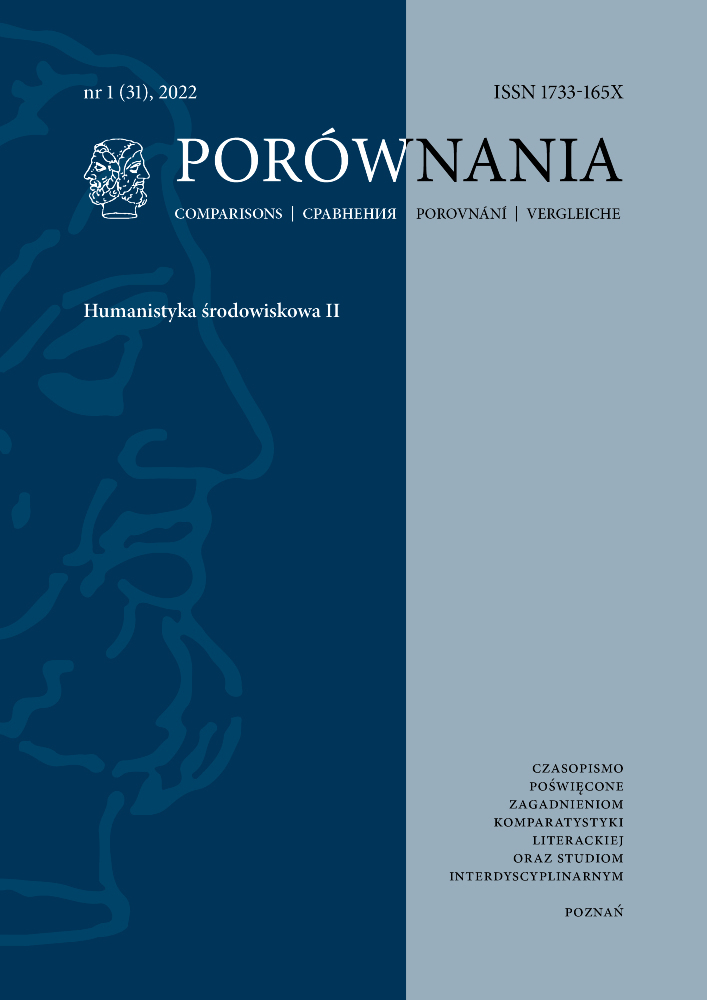Abstract
The text is an attempt to demonstrate how stories about vampires—ubiquitous in contemporary culture—fit into an accessible version of the issues raised within animal studies. Since the character of the vampire is one of those elements of the Gothic canon that has undergone a dizzying transformation ( there seems to be more differences than shared features between Bram Stoker’s Dracula and Stephenie Meyer’s Twilight heroes ), the article examines the reasons for such a radical change in our stories about fictitious creatures that we have placed above us in the food chain.
Jim Jarmusch’s film Only Lovers Left Alive has been analysed in more detail in the article; however, other ( apart from the already mentioned ) “canonical” texts are mentioned, such as Interview with the Vampire by Anne Rice, and some less known ones, including Suzy McKee-Charnas’ The Vampire Tapestry or Truth by Terry Pratchett.
References
Auerbach Nina, Our Vampires, Ourselves, The Univeristy of Chicago Press, Chicago i Londyn, 1995. https://doi.org/10.7208/chicago/9780226056180.001.0001
Blake Linnie (2012), Vampires, Mad Scientists and the Unquiet Dead. Gothic Ubiquity in Post-9/11 US Television, w: The Gothic in Contemporary Literature and Popular Culture. Pop Goth, red. J. D. Edwards i A. Soltysik Monnet, Routladge, Londyn i Nowy Jork, 2012, s. 37-56.
Botting Fred, Gothic Romanced. Consumption, Gender and Technology in Contemporary Fictions, Routledge, Londyn i Nowy Jork 2008. https://doi.org/10.4324/9780203090718
Botting Fred, Limits of Horror. Technology, Bodies, Gothic, Manchester and New York: Manchester University Press, 2008. Print.
Brace Patricia, Arp Robert, Wyjście z trumny a wyjście z szafy, przeł. K. Schmidt, w: Czysta krew i filozofia. Wampiry stają się naprawdę niegrzeczne, red. W. Irwin, G. A. Dunn, R. Housel, Wydawnictwo HELION, Gliwice 2010, s. 101-118.
Brzostek Dariusz, Drapieżnik i (jego) ofiara. Horror w kontekście ewolucjonistycznych teorii narracji, w: Literatura i kultura popularne. Badania, analizy i interpretacje, red. A Gemra, Pracownia Literatury i Kultury Popularnej oraz Nowych Mediów, Wrocław 2015, s. 49-58.
Furlińska Agnieszka, Dlaczego literatura popularna jest popularna?, "Teksty Drugie" 2003, nr 4, s. 55-66.
Gelder Ken, Reading the Vampire, Routledge, Londyn i Nowy Jork, 1994. https://doi.org/10.4324/9780203320266
Gemra Anna, Od gotycyzmu do horroru. Wilkołak, wampir i monstrum Fraknensteina w wybranych utworach, Wydawnistwo Uniwersytetu Wrocławskiego, Wrocław 2008.
Grady Franks, Vampire Culture, w: Monster Theory, red. J. J. Cohen, University of Minnesota Press, Minneapolis i Londyn, 1996, s. 225-241. https://doi.org/10.5749/j.ctttsq4d.14
Harris Charleine, Martwy jak zimny trup, przeł. E. Wojtczak, Wydawnictwo MAG, Warszawa 2010.
Hughes William, Key Concepts in the Gothic, Edinburgh University Press, Edynburg 2018. https://doi.org/10.1515/9781474405546
Irwin William, Housel Rebecca, Wisnewski J. Jeremy, "Zmierzch" i filozofia. Wampiry, wegetarianie i pogoń za nieśmiertelnością, przeł. A. Krzysztoń i J. Urban, Prószyński i S-ka, Warszawa 2009.
Izdebska Agnieszka, Nostalgic aliens and troublesome citizens - on vampire stories once again, "Zagadnienia Rodzajów Literackich" t. LXII, z. 1 (129), 2019, s. 27-39.
Janion Maria, Wampir: biografia symboliczna, słowo/obraz/terytoria, Gdańsk 2004.
Leduff Charlie, Detroit. Sekcja zwłok Ameryki, przeł. I. Noszczyk, Wydawnictwo Czarne, Wołowiec 2015.
Marcela Mikołaj, Monstruarium nowoczesne, Wydawnictwo Uniwersytetu Śląskiego, Katowice 2015.
McKee-Charnas Suzy, Gobelin z wampirem, przeł. J. Ruszkowski, Dom Wydawniczy REBIS, Poznań 1992.
Pratchett Terry, Prawda, przeł. P.W. Cholewa, Prószyński i S-ka, Warszawa 1999.
Singer Peter, Wyzwolenie zwierząt, przeł. A. Alichniewicz i A. Szczęsna, Wydawnictwo Marginesy, Warszawa 2018.
Twain Mark, Pamiętniki Adama i Ewy, przeł. T. Truszkowska, Wydawnictwo Literackie, Kraków 1977.
Weinstock Jeffrey Andrew, Invisible Monsters: Vision, Horror and Contemporary Culture, w: The Ashgate Research Companion to Monsters and the Monstrosity, red. A.S. Mittman i P.J. Dendle, Routledge, Londyn i Nowy Jork, 2013, s. 275-289.
Weinstock Jeffrey Andrew, American Vampires, w: American Gothic Culture. An Edinbourgh Companion, red. J. Faflak i J. Haslam, Edinburgh University Press, Edynburg 2016, s. 203-221. https://doi.org/10.1515/9781474401623-012
Zanger Jules, Metaphor into Metonymy: The Vampire Next Door, w: Blood Read: The Vampire as a Metaphor in Contemporary Culture, red. J. Gordon i V. Hollinger, University of Pennsylvania Press, Filadelfia 1997, s. 17-26.
Zwierzchowski Piotr, Smutek wiecznego życia. Filmowe wyobrażenia mitu o nieśmiertelności, "Kwartalnik Filmowy" 2003 nr 41-42, s. 273-295.
License
Utwory opublikowane w czasopiśmie „Porównania”, na platformie Pressto należącej do Uniwersytetu im. Adama Mickiewicza w Poznaniu są udostępniane na licencji Creative Commons Uznanie autorstwa - Bez utworów zależnych 4.0 Międzynarodowe (CC BY-ND 4.0)
Tym samym wszyscy zainteresowani są uprawnieni do korzystania z utworów opublikowanych pod następującymi warunkami:
-
uznania autorstwa — czyli obowiązek podania wraz z rozpowszechnianym utworem informacji o autorstwie, tytule, źródle (odnośniki do oryginalnego utworu, doi) oraz samej licencji
-
bez utworów zależnych — remiksując, przetwarzając lub tworząc na podstawie utworu, nie wolno rozpowszechniać zmodyfikowanych treści.
-
brak dodatkowych ograniczeń — nie można korzystać ze środków prawnych lub technologicznych, które ograniczają innych w korzystaniu z utworu na warunkach określonych w licencji.
Uniwersytet im. Adama Mickiewicza w Poznaniu zachowuje prawo do czasopisma jako całości (układ, forma graficzna, tytuł, projekt okładki, logo itp.).
Autor zachowuje prawa majątkowe, ale udziela zgody Uniwersytetowi im. Adama Mickiewicza w Poznaniu na wykorzystanie dzieła. Autorzy tekstów zakwalifikowanych do publikacji proszeni są o wypełnienie podpisanie i przesłanie umowa (PL) agreement (EN)
Agreement for granting a royalty-free license to works with a commitment to grant a CC sub-license





